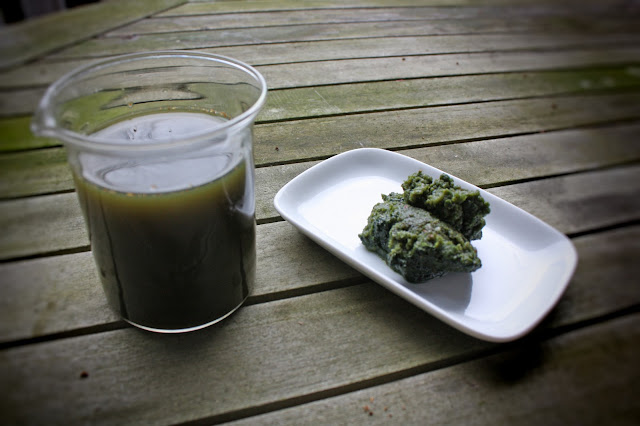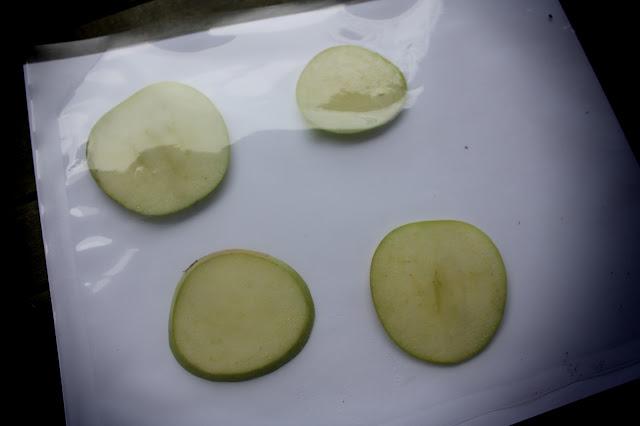I've seen several well-done accounts recently that demonstrate insta-pickling and the suspension of liquid into foods using a heavy vacuum so rather than repeat a blog post that's already been done I thought I'd take different approach and use my 3D animation background to show a "behind the scenes" look of what's actually happening at the cellular level.
Waking up on Monday with compression in my head, I rushed out of the house for a quick stop at my local Mekong Market, a virtual treasure trove of "new" foods for me to work with. The compression technique does a bang up job on many foods, provided they have a porous structure and although I had a few ideas of items I might try, I was excited to see what other vegetable mysteries the Mekong Market had to offer.
Upon entering the store I made a bee-line for the Bac Ha, known in English as Taro Stem. Although called Taro Stem, this vegetable is not the stalk of the two-finger/three-finger tuber that tastes like glue. Bac Ha IS in the same family as its pasty cousin, but it's almost always the shoot of this plant which is eaten and not the root (or in taro-talk the 'corn'). I've eaten Bac Ha many times before, typically as a crunchy add-in to Asian soups, and I remembered it as being one of the most porous vegetables I could think of.....on second thought, maybe TOO porous. I needed a backup.
bac ha
In case compressing the Bac Ha was a bust I also purchased a handful of Yampi, a cool, albeit pancreatic looking root, a can of pomegranate drink, a Fuji apple, some lemongrass, hot basil, and a handful of la lot. Once home I quickly discovered online that the yampi is a type of Caribbean Yam that I knew would most likely be too dense for compression (another blog?).
yampi
Still hoping to get my initial ingredient to work, I grabbed a stalk of Bac Ha and retired to my office to eat it, contemplate complimentary flavors to infuse it with, and begin the process of writing down my tasting notes. Mid-way through my research, and about 6 inches into devouring the airy stalk I came across a website with this line:
"bac ha must be carefully cooked before consumption, or the plant can stimulate an adverse reaction.
The reaction is caused by raphides, crystals of calcium oxalate which form in the cells of the stalks and corms of the plant. The crystals take on a needle-like structure, which causes them to pierce mucus membranes, resulting in severe irritation to the consumer."
Oops.
This left me with lemongrass and la lot. Lemongrass is hardly what I would consider an "unusual food" and therefor out of the running for this post. When William Sonoma makes a dish soap that smells like you, you're pretty damn mainstream in my book. This left la lot. La lot, also called betel leaf is, like the aforementioned taro stalk, another poorly named organic. La lot is often mistaken for the addictive, psycho-stimulating concoction called betel quid whose components are betel leaf, areca nut, slaked lime and sometimes tobacco. The two are often mistaken because in English, like the taro fiasco of earlier, they have the SAME NAME!? The effects of the stimulant betel quid are often mild and comparable to a cup of coffee or, in the version with added tobacco, a cup of coffee and a cigarette (addiction multitasking). La lot is often sold in markets in the U.S. labeled as betel leaf but again, despite the SAME name as the leaf used in betel quid, it is a completely different plant altogether.
It's rather common when traveling throughout Asia to see people chewing the stimulant (see: fun) "version" in everyday life. Even when not actively 'tripping', betel quid users are pretty easy to spot in a crowd as their teeth and gums are stained an insane red.
The betel leaf sold in the fresh veggie isle of many Asian markets, and the one used in the application posted here however will not stain your teeth and gums, nor make you see god. Although both the tasty and the feel-good varieties of these leaves are in the same Piper genus, they share about as much in common as spinach and beets which share the genus Chenopodiaceae; completely different plants in taste and shape and unfortunately, neither of which will make you high.
La lot has a very aromatic and somewhat peppery flavor that becomes even more pronounced when cooked. I decided to pair (compress) this flavor into sliced apple where the sweetness of the fruit would complement the herbal bite.
la lot, thai chili, apple, mirasol chili, basil
betel infusion
la lot leaves - 40g
fish sauce 20g
brown sugar 40g
thai chili x1
star anise x1
brown sugar 40g
thai chili x1
star anise x1
pomegranate juice drink - 100g
Blend all ingredients on high until fully liquid. Proportions given are approximate and should be adjusted based on personal taste.
centrifuge
I ran the resulting liquid from step 1 in my centrifuge (because I have one) for about 20 minutes at 3800 RPMs to remove as many solids as possible before compression . If for some odd reason you don't have a centrifuge at home you can most assuredly get a similar result with a strainer. If you don't have a strainer, buy one.
la lot infusion liquid, pulp
It's always a good idea when centrifuging (or straining) foods to taste all of the resulting layers separately before discarding. Some really interesting flavors can be discovered this way from items that you may instinctively want to toss. In the case of la lot I've already done the tasting for you. Ditch the pulp.
fuji apple
Cut apple into 1/4 inch slices and position them for compression. Compression infusion can be done in a vacuum bag, which is then sealed in the chamber after the air is evacuated, or in an unsealable and open container, providing the food is submerged in liquid. Compression occurs when the cells of the food are disrupted by the vacuum process and then returned to atmospheric pressure, not by the collapse of the bag they're in. Because of the amount of vacuum required, compressing foods will not work in off the shelf 'Food Saver' systems that suck the air (and liquid) from the bag. A chamber vac is needed for this process (a more than worthy investment that will pay for itself in keep-cheese-from-molding costs alone, or if you don't care about your cheese, check out this post on the website Cooking Issues for a fantastic and super inexpensive do-it-yourself alternative here).
Compression: The Main Event
Spoiler Alert: If you haven't watched my above video on compression yet the following description gives away the plot, AND the ending. You have been warned.
Add the la lot liquid to the container with the apples and vacuum. As this video shows, as the pressure inside the chamber vac decreases so does the boiling point. The surrounding liquid begins to boil even though no heat has been introduced. On the cellular level the cells of the the apple start to swell. The vacuoles inside of each cell also begin to grow and shift until, like an overinflated balloon, they pop. These mini explosions leave voids inside each cell where the vacuole used to live. Once the chamber vac valve is released and the apple slices return to atmospheric pressure, a desperate land grab to occupy the empty vacuole space ensues. In this instance, instead of air being able to rush in to fill the void, la lot juice has moved in next door to the apples and is more than happy to take the space. Result: perfectly infused fruit with a dense la lot and flavor.
la lot infused apple
mesquite grill
Sear infused apple slices on the grill. The natural sugar in the apples, as well as that added to the infused sauce will caramelize and contrast beautifully with the saltiness of the fish sauce and herbal flavor of the la lot
plated dish
serve with finely chopped mirasol pepper and basil chiffonade














By using a food vacuum sealer is a powerful way to save money through getting food available for sale and also preserving that.
ReplyDeleteVacuum sealers have been around for some time, but there are many things you may not know about them. First of all, no vacuum cleaners are involved, however, a lot of suction is.
ReplyDelete